FORD F650 2008 11.G Owners Manual
Manufacturer: FORD, Model Year: 2008, Model line: F650, Model: FORD F650 2008 11.GPages: 273, PDF Size: 1.71 MB
Page 201 of 273
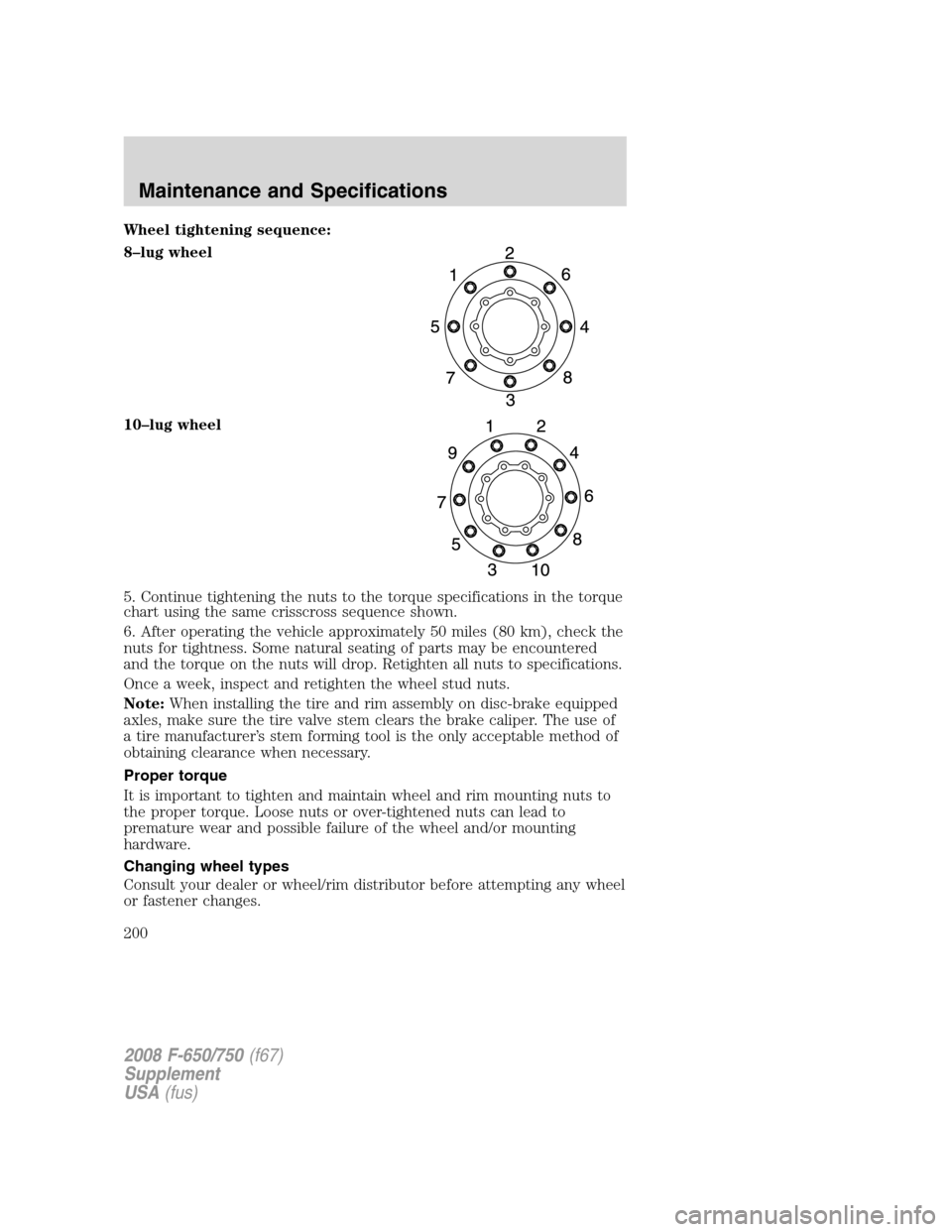
Wheel tightening sequence:
8–lug wheel
10–lug wheel
5. Continue tightening the nuts to the torque specifications in the torque
chart using the same crisscross sequence shown.
6. After operating the vehicle approximately 50 miles (80 km), check the
nuts for tightness. Some natural seating of parts may be encountered
and the torque on the nuts will drop. Retighten all nuts to specifications.
Once a week, inspect and retighten the wheel stud nuts.
Note:When installing the tire and rim assembly on disc-brake equipped
axles, make sure the tire valve stem clears the brake caliper. The use of
a tire manufacturer’s stem forming tool is the only acceptable method of
obtaining clearance when necessary.
Proper torque
It is important to tighten and maintain wheel and rim mounting nuts to
the proper torque. Loose nuts or over-tightened nuts can lead to
premature wear and possible failure of the wheel and/or mounting
hardware.
Changing wheel types
Consult your dealer or wheel/rim distributor before attempting any wheel
or fastener changes.
2008 F-650/750(f67)
Supplement
USA(fus)
Maintenance and Specifications
200
Page 202 of 273
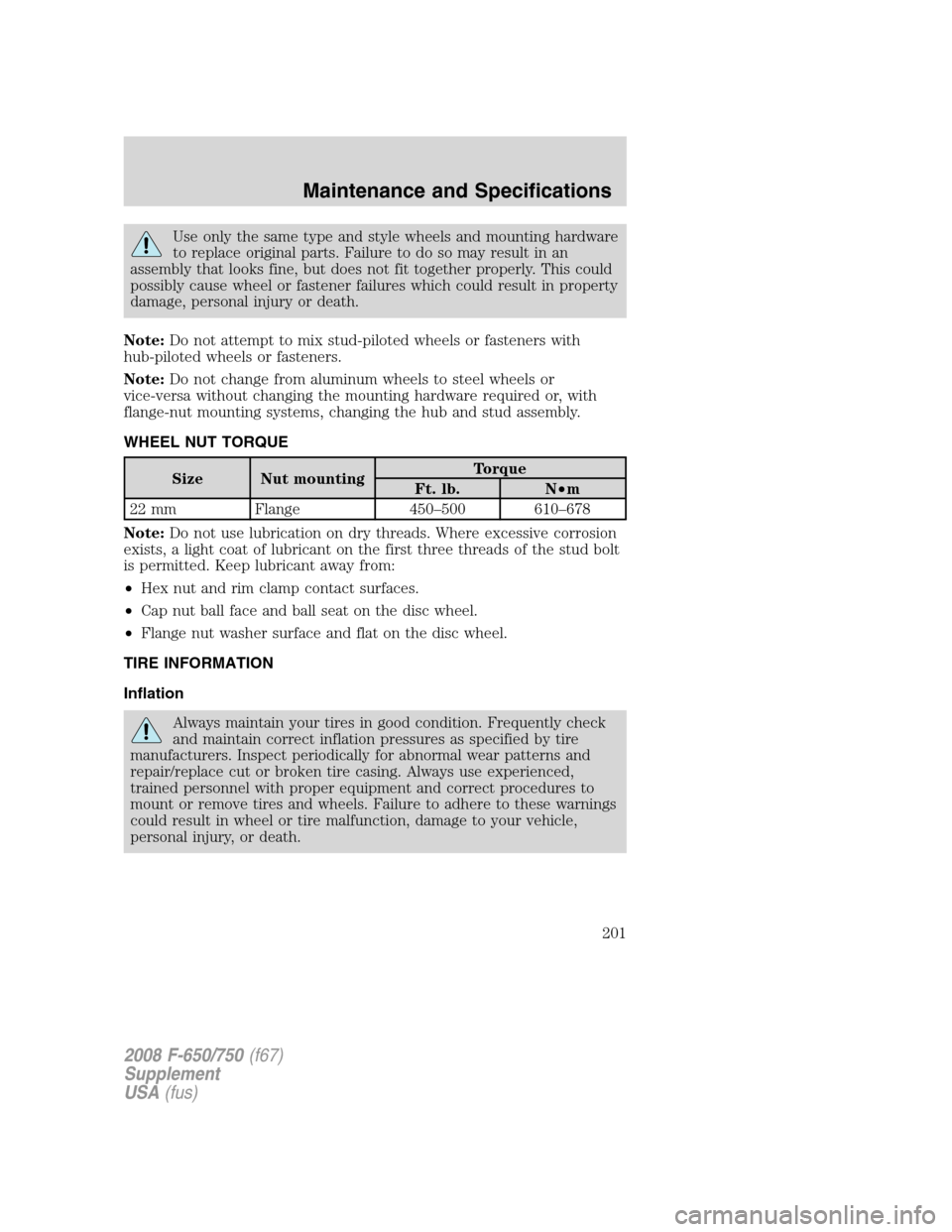
Use only the same type and style wheels and mounting hardware
to replace original parts. Failure to do so may result in an
assembly that looks fine, but does not fit together properly. This could
possibly cause wheel or fastener failures which could result in property
damage, personal injury or death.
Note:Do not attempt to mix stud-piloted wheels or fasteners with
hub-piloted wheels or fasteners.
Note:Do not change from aluminum wheels to steel wheels or
vice-versa without changing the mounting hardware required or, with
flange-nut mounting systems, changing the hub and stud assembly.
WHEEL NUT TORQUE
Size Nut mountingTorque
Ft. lb. N•m
22 mm Flange 450–500 610–678
Note:Do not use lubrication on dry threads. Where excessive corrosion
exists, a light coat of lubricant on the first three threads of the stud bolt
is permitted. Keep lubricant away from:
•Hex nut and rim clamp contact surfaces.
•Cap nut ball face and ball seat on the disc wheel.
•Flange nut washer surface and flat on the disc wheel.
TIRE INFORMATION
Inflation
Always maintain your tires in good condition. Frequently check
and maintain correct inflation pressures as specified by tire
manufacturers. Inspect periodically for abnormal wear patterns and
repair/replace cut or broken tire casing. Always use experienced,
trained personnel with proper equipment and correct procedures to
mount or remove tires and wheels. Failure to adhere to these warnings
could result in wheel or tire malfunction, damage to your vehicle,
personal injury, or death.
2008 F-650/750(f67)
Supplement
USA(fus)
Maintenance and Specifications
201
Page 203 of 273
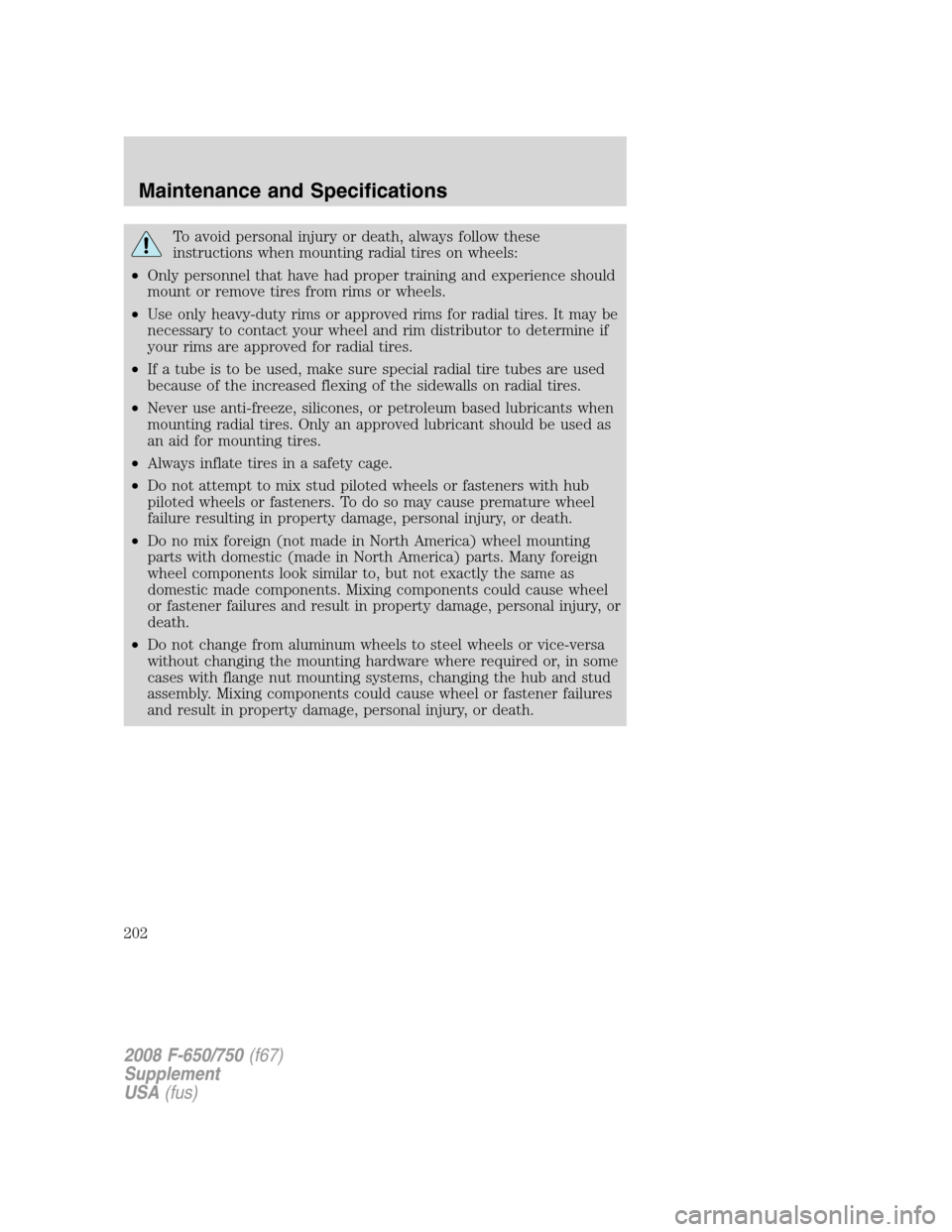
To avoid personal injury or death, always follow these
instructions when mounting radial tires on wheels:
•Only personnel that have had proper training and experience should
mount or remove tires from rims or wheels.
•Use only heavy-duty rims or approved rims for radial tires. It may be
necessary to contact your wheel and rim distributor to determine if
your rims are approved for radial tires.
•If a tube is to be used, make sure special radial tire tubes are used
because of the increased flexing of the sidewalls on radial tires.
•Never use anti-freeze, silicones, or petroleum based lubricants when
mounting radial tires. Only an approved lubricant should be used as
an aid for mounting tires.
•Always inflate tires in a safety cage.
•Do not attempt to mix stud piloted wheels or fasteners with hub
piloted wheels or fasteners. To do so may cause premature wheel
failure resulting in property damage, personal injury, or death.
•Do no mix foreign (not made in North America) wheel mounting
parts with domestic (made in North America) parts. Many foreign
wheel components look similar to, but not exactly the same as
domestic made components. Mixing components could cause wheel
or fastener failures and result in property damage, personal injury, or
death.
•Do not change from aluminum wheels to steel wheels or vice-versa
without changing the mounting hardware where required or, in some
cases with flange nut mounting systems, changing the hub and stud
assembly. Mixing components could cause wheel or fastener failures
and result in property damage, personal injury, or death.
2008 F-650/750(f67)
Supplement
USA(fus)
Maintenance and Specifications
202
Page 204 of 273
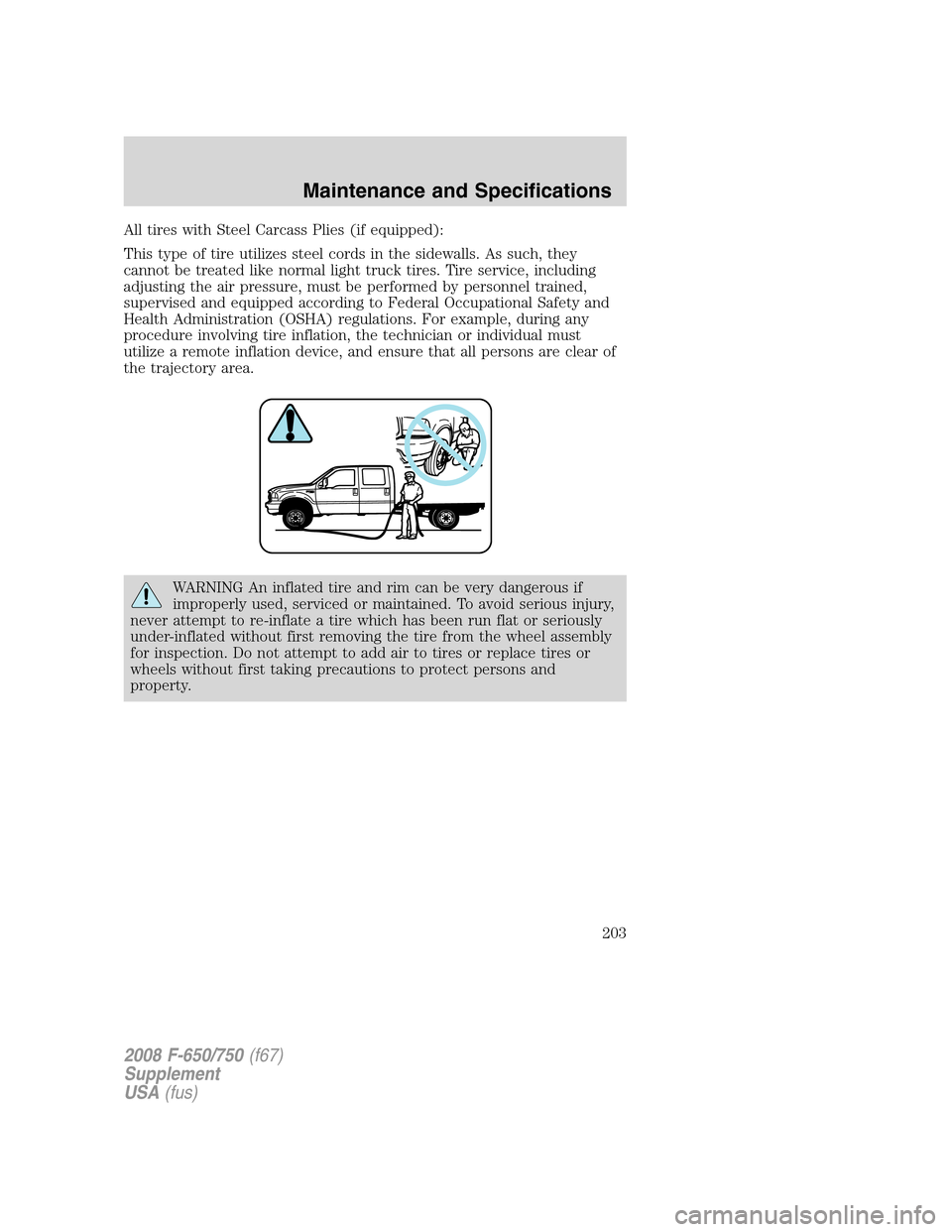
All tires with Steel Carcass Plies (if equipped):
This type of tire utilizes steel cords in the sidewalls. As such, they
cannot be treated like normal light truck tires. Tire service, including
adjusting the air pressure, must be performed by personnel trained,
supervised and equipped according to Federal Occupational Safety and
Health Administration (OSHA) regulations. For example, during any
procedure involving tire inflation, the technician or individual must
utilize a remote inflation device, and ensure that all persons are clear of
the trajectory area.
WARNING An inflated tire and rim can be very dangerous if
improperly used, serviced or maintained. To avoid serious injury,
never attempt to re-inflate a tire which has been run flat or seriously
under-inflated without first removing the tire from the wheel assembly
for inspection. Do not attempt to add air to tires or replace tires or
wheels without first taking precautions to protect persons and
property.
2008 F-650/750(f67)
Supplement
USA(fus)
Maintenance and Specifications
203
Page 205 of 273
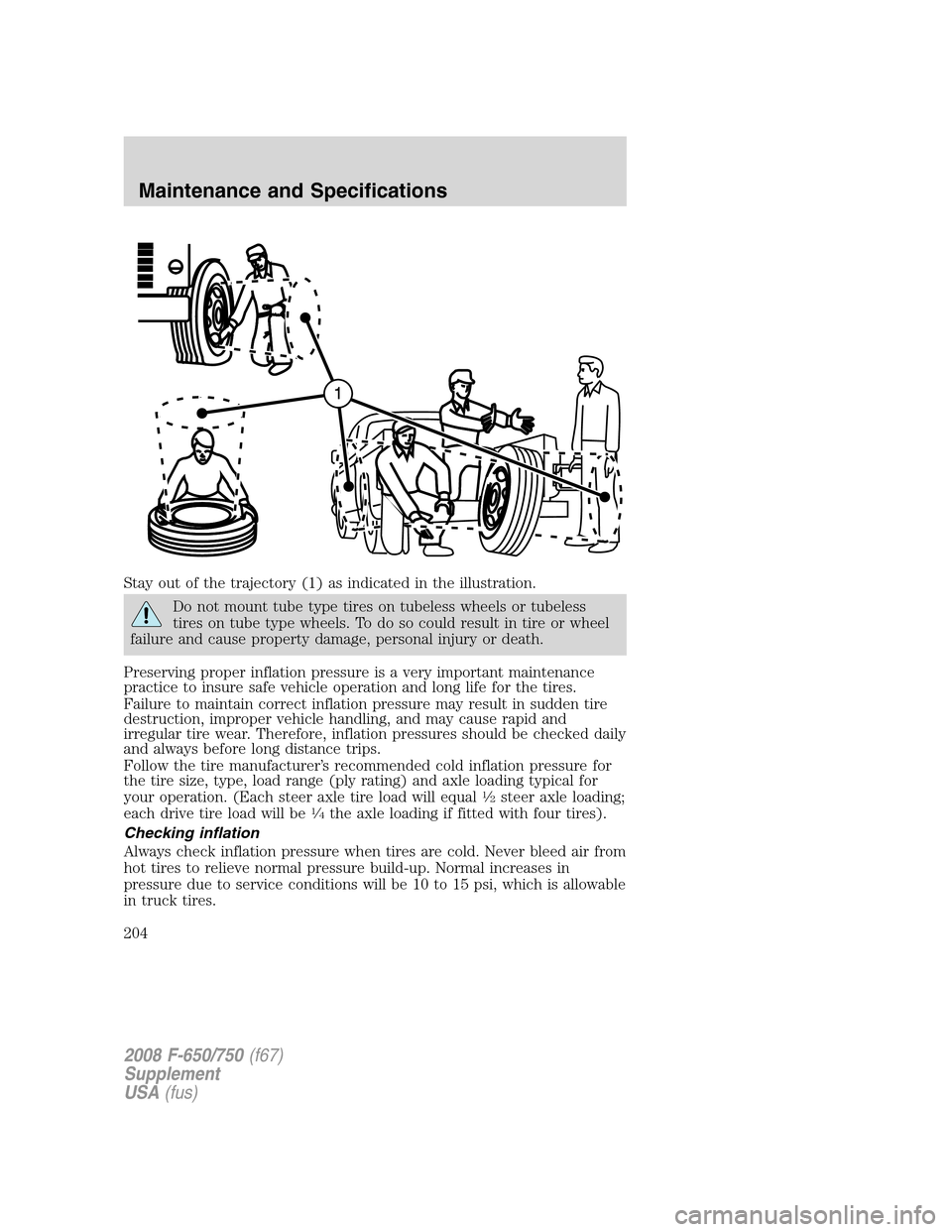
Stay out of the trajectory (1) as indicated in the illustration.
Do not mount tube type tires on tubeless wheels or tubeless
tires on tube type wheels. To do so could result in tire or wheel
failure and cause property damage, personal injury or death.
Preserving proper inflation pressure is a very important maintenance
practice to insure safe vehicle operation and long life for the tires.
Failure to maintain correct inflation pressure may result in sudden tire
destruction, improper vehicle handling, and may cause rapid and
irregular tire wear. Therefore, inflation pressures should be checked daily
and always before long distance trips.
Follow the tire manufacturer’s recommended cold inflation pressure for
the tire size, type, load range (ply rating) and axle loading typical for
your operation. (Each steer axle tire load will equal
1�2steer axle loading;
each drive tire load will be1�4the axle loading if fitted with four tires).
Checking inflation
Always check inflation pressure when tires are cold. Never bleed air from
hot tires to relieve normal pressure build-up. Normal increases in
pressure due to service conditions will be 10 to 15 psi, which is allowable
in truck tires.
2008 F-650/750(f67)
Supplement
USA(fus)
Maintenance and Specifications
204
Page 206 of 273
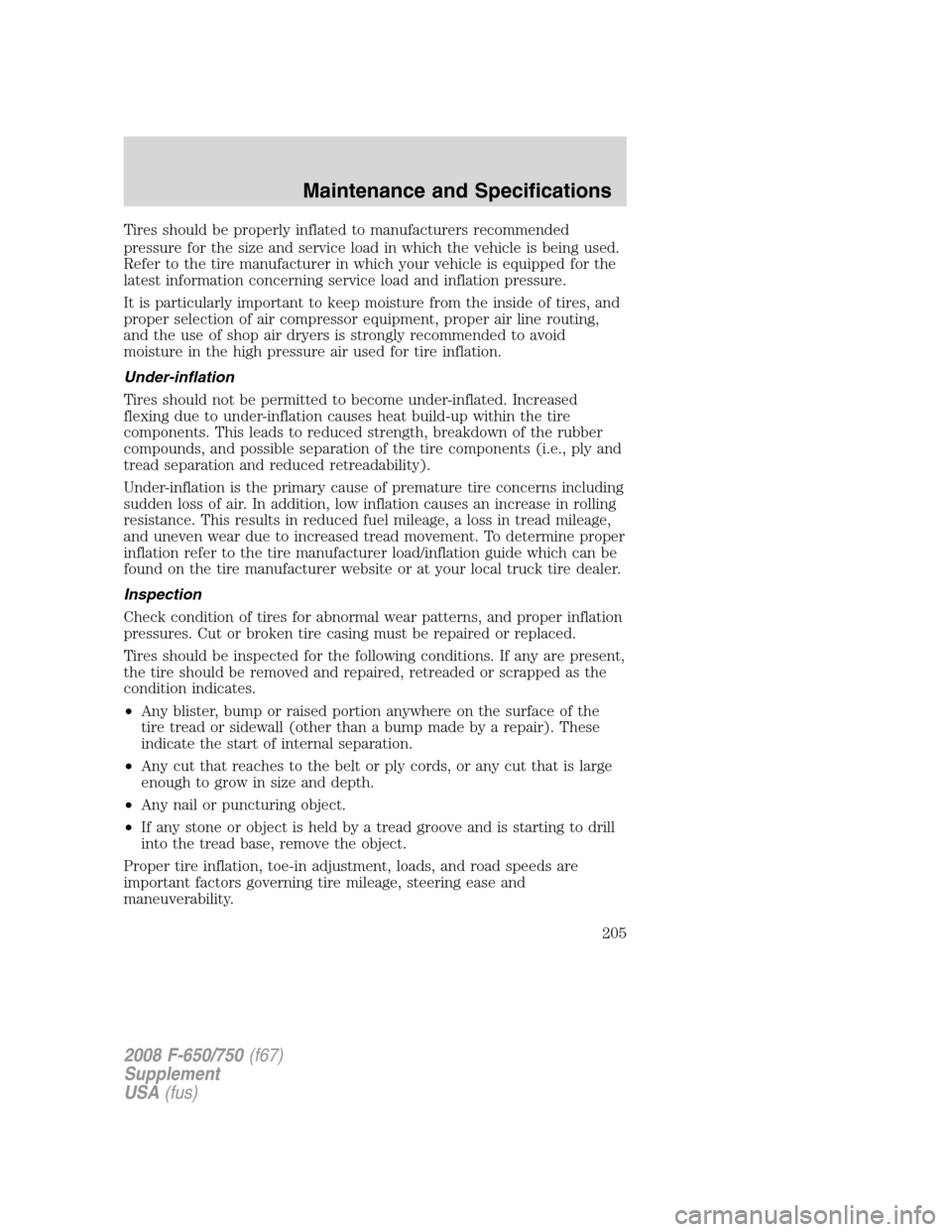
Tires should be properly inflated to manufacturers recommended
pressure for the size and service load in which the vehicle is being used.
Refer to the tire manufacturer in which your vehicle is equipped for the
latest information concerning service load and inflation pressure.
It is particularly important to keep moisture from the inside of tires, and
proper selection of air compressor equipment, proper air line routing,
and the use of shop air dryers is strongly recommended to avoid
moisture in the high pressure air used for tire inflation.
Under-inflation
Tires should not be permitted to become under-inflated. Increased
flexing due to under-inflation causes heat build-up within the tire
components. This leads to reduced strength, breakdown of the rubber
compounds, and possible separation of the tire components (i.e., ply and
tread separation and reduced retreadability).
Under-inflation is the primary cause of premature tire concerns including
sudden loss of air. In addition, low inflation causes an increase in rolling
resistance. This results in reduced fuel mileage, a loss in tread mileage,
and uneven wear due to increased tread movement. To determine proper
inflation refer to the tire manufacturer load/inflation guide which can be
found on the tire manufacturer website or at your local truck tire dealer.
Inspection
Check condition of tires for abnormal wear patterns, and proper inflation
pressures. Cut or broken tire casing must be repaired or replaced.
Tires should be inspected for the following conditions. If any are present,
the tire should be removed and repaired, retreaded or scrapped as the
condition indicates.
•Any blister, bump or raised portion anywhere on the surface of the
tire tread or sidewall (other than a bump made by a repair). These
indicate the start of internal separation.
•Any cut that reaches to the belt or ply cords, or any cut that is large
enough to grow in size and depth.
•Any nail or puncturing object.
•If any stone or object is held by a tread groove and is starting to drill
into the tread base, remove the object.
Proper tire inflation, toe-in adjustment, loads, and road speeds are
important factors governing tire mileage, steering ease and
maneuverability.
2008 F-650/750(f67)
Supplement
USA(fus)
Maintenance and Specifications
205
Page 207 of 273
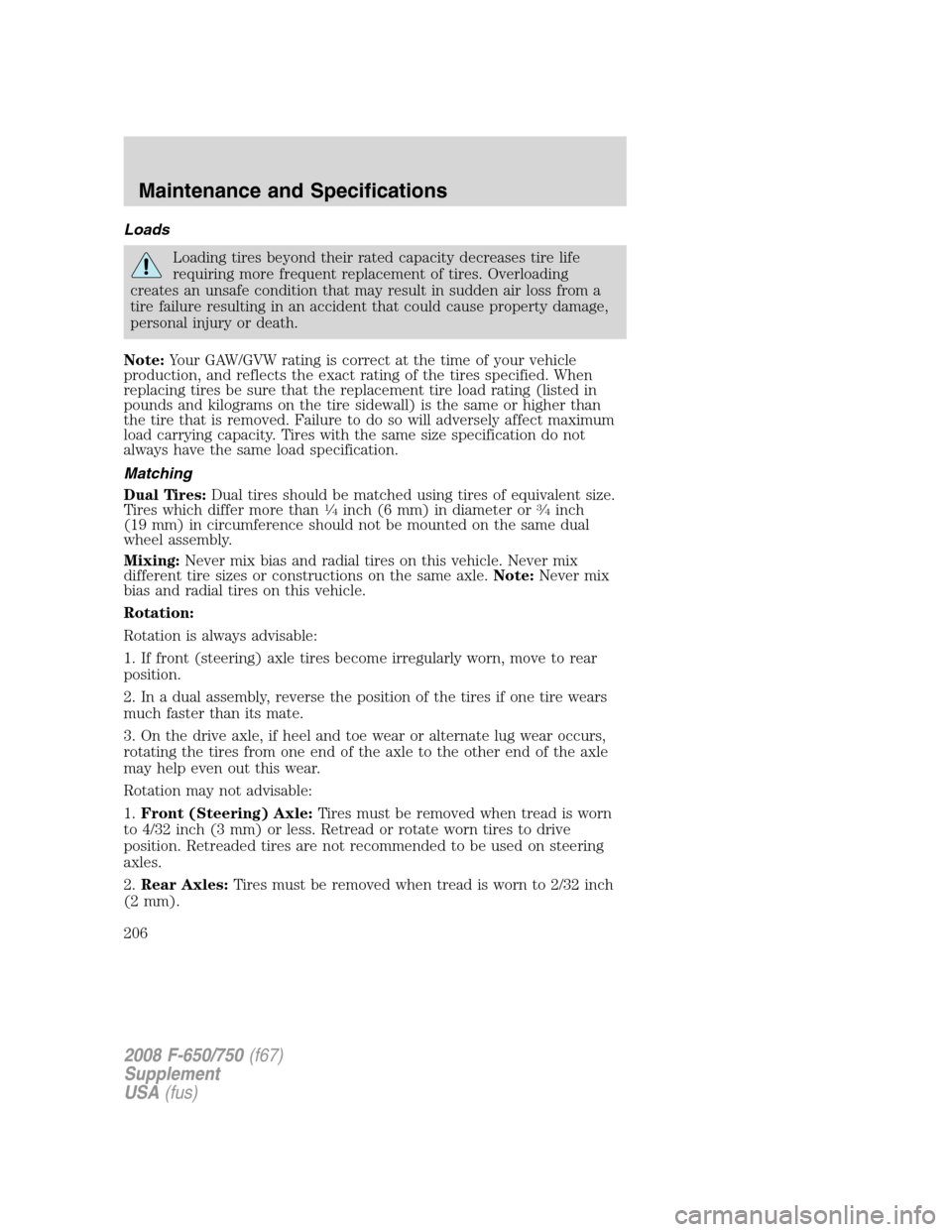
Loads
Loading tires beyond their rated capacity decreases tire life
requiring more frequent replacement of tires. Overloading
creates an unsafe condition that may result in sudden air loss from a
tire failure resulting in an accident that could cause property damage,
personal injury or death.
Note:Your GAW/GVW rating is correct at the time of your vehicle
production, and reflects the exact rating of the tires specified. When
replacing tires be sure that the replacement tire load rating (listed in
pounds and kilograms on the tire sidewall) is the same or higher than
the tire that is removed. Failure to do so will adversely affect maximum
load carrying capacity. Tires with the same size specification do not
always have the same load specification.
Matching
Dual Tires:Dual tires should be matched using tires of equivalent size.
Tires which differ more than
1�4inch (6 mm) in diameter or3�4inch
(19 mm) in circumference should not be mounted on the same dual
wheel assembly.
Mixing:Never mix bias and radial tires on this vehicle. Never mix
different tire sizes or constructions on the same axle.Note:Never mix
bias and radial tires on this vehicle.
Rotation:
Rotation is always advisable:
1. If front (steering) axle tires become irregularly worn, move to rear
position.
2. In a dual assembly, reverse the position of the tires if one tire wears
much faster than its mate.
3. On the drive axle, if heel and toe wear or alternate lug wear occurs,
rotating the tires from one end of the axle to the other end of the axle
may help even out this wear.
Rotation may not advisable:
1.Front (Steering) Axle:Tires must be removed when tread is worn
to 4/32 inch (3 mm) or less. Retread or rotate worn tires to drive
position. Retreaded tires are not recommended to be used on steering
axles.
2.Rear Axles:Tires must be removed when tread is worn to 2/32 inch
(2 mm).
2008 F-650/750(f67)
Supplement
USA(fus)
Maintenance and Specifications
206
Page 208 of 273
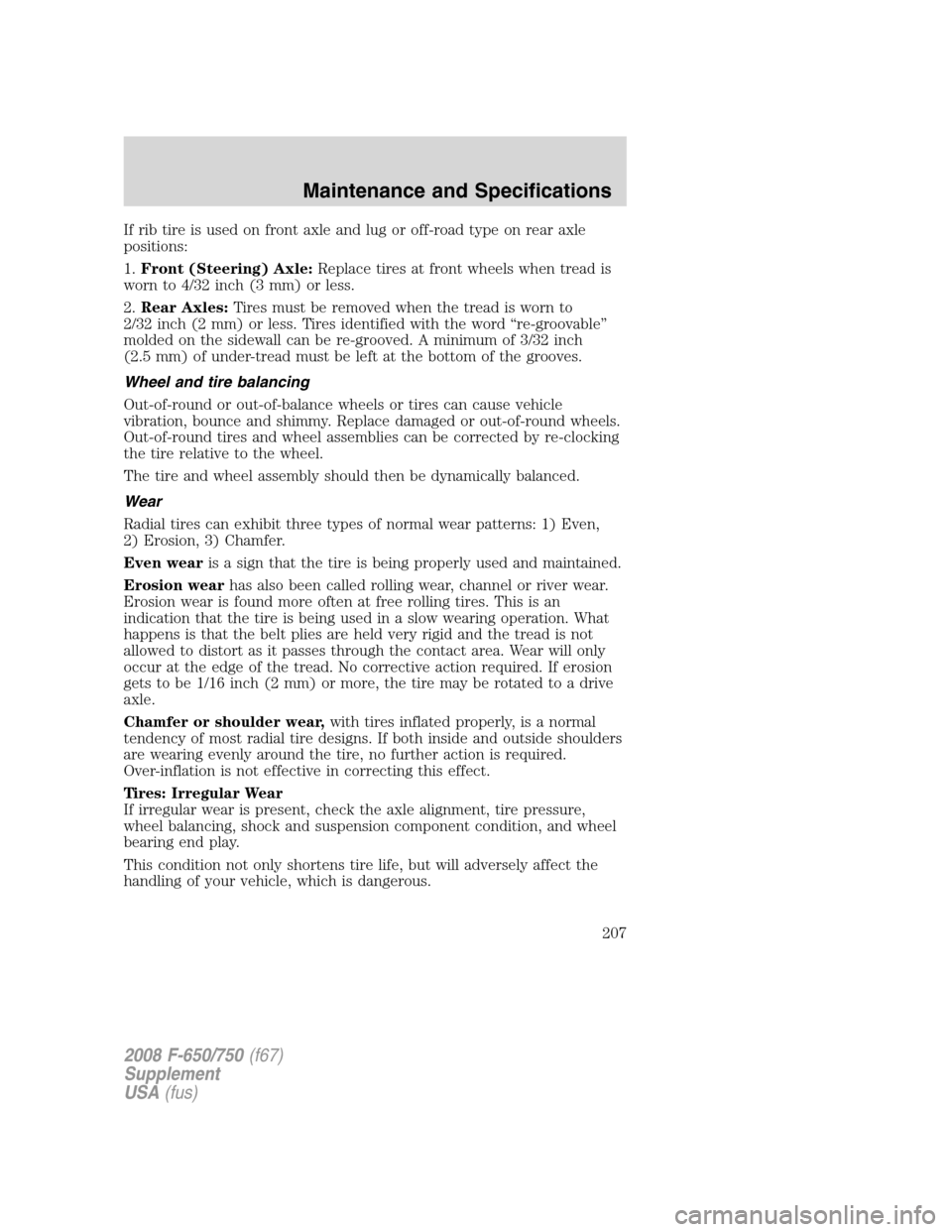
If rib tire is used on front axle and lug or off-road type on rear axle
positions:
1.Front (Steering) Axle:Replace tires at front wheels when tread is
worn to 4/32 inch (3 mm) or less.
2.Rear Axles:Tires must be removed when the tread is worn to
2/32 inch (2 mm) or less. Tires identified with the word “re-groovable”
molded on the sidewall can be re-grooved. A minimum of 3/32 inch
(2.5 mm) of under-tread must be left at the bottom of the grooves.
Wheel and tire balancing
Out-of-round or out-of-balance wheels or tires can cause vehicle
vibration, bounce and shimmy. Replace damaged or out-of-round wheels.
Out-of-round tires and wheel assemblies can be corrected by re-clocking
the tire relative to the wheel.
The tire and wheel assembly should then be dynamically balanced.
Wear
Radial tires can exhibit three types of normal wear patterns: 1) Even,
2) Erosion, 3) Chamfer.
Even wearis a sign that the tire is being properly used and maintained.
Erosion wearhas also been called rolling wear, channel or river wear.
Erosion wear is found more often at free rolling tires. This is an
indication that the tire is being used in a slow wearing operation. What
happens is that the belt plies are held very rigid and the tread is not
allowed to distort as it passes through the contact area. Wear will only
occur at the edge of the tread. No corrective action required. If erosion
gets to be 1/16 inch (2 mm) or more, the tire may be rotated to a drive
axle.
Chamfer or shoulder wear,with tires inflated properly, is a normal
tendency of most radial tire designs. If both inside and outside shoulders
are wearing evenly around the tire, no further action is required.
Over-inflation is not effective in correcting this effect.
Tires: Irregular Wear
If irregular wear is present, check the axle alignment, tire pressure,
wheel balancing, shock and suspension component condition, and wheel
bearing end play.
This condition not only shortens tire life, but will adversely affect the
handling of your vehicle, which is dangerous.
2008 F-650/750(f67)
Supplement
USA(fus)
Maintenance and Specifications
207
Page 209 of 273
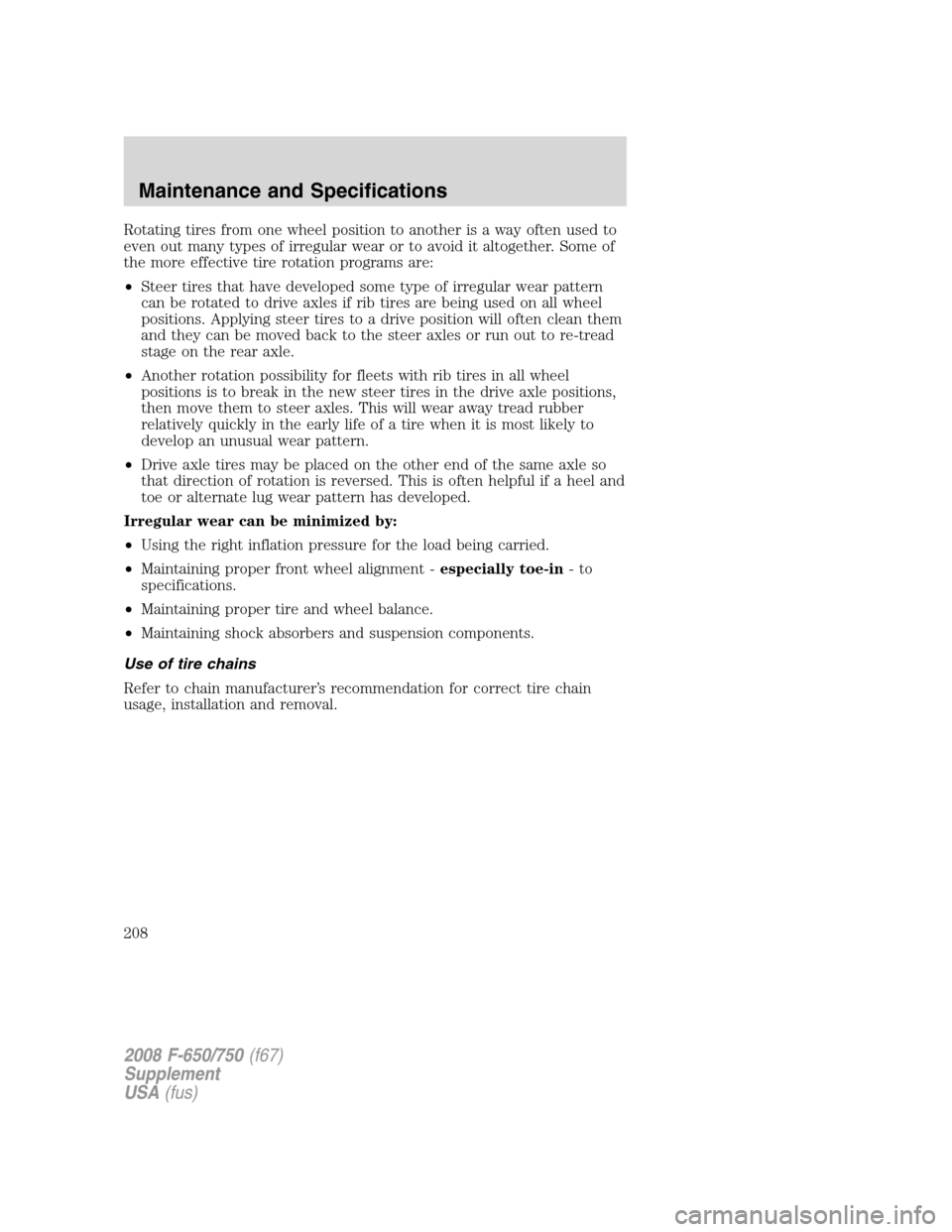
Rotating tires from one wheel position to another is a way often used to
even out many types of irregular wear or to avoid it altogether. Some of
the more effective tire rotation programs are:
•Steer tires that have developed some type of irregular wear pattern
can be rotated to drive axles if rib tires are being used on all wheel
positions. Applying steer tires to a drive position will often clean them
and they can be moved back to the steer axles or run out to re-tread
stage on the rear axle.
•Another rotation possibility for fleets with rib tires in all wheel
positions is to break in the new steer tires in the drive axle positions,
then move them to steer axles. This will wear away tread rubber
relatively quickly in the early life of a tire when it is most likely to
develop an unusual wear pattern.
•Drive axle tires may be placed on the other end of the same axle so
that direction of rotation is reversed. This is often helpful if a heel and
toe or alternate lug wear pattern has developed.
Irregular wear can be minimized by:
•Using the right inflation pressure for the load being carried.
•Maintaining proper front wheel alignment -especially toe-in-to
specifications.
•Maintaining proper tire and wheel balance.
•Maintaining shock absorbers and suspension components.
Use of tire chains
Refer to chain manufacturer’s recommendation for correct tire chain
usage, installation and removal.
2008 F-650/750(f67)
Supplement
USA(fus)
Maintenance and Specifications
208
Page 210 of 273
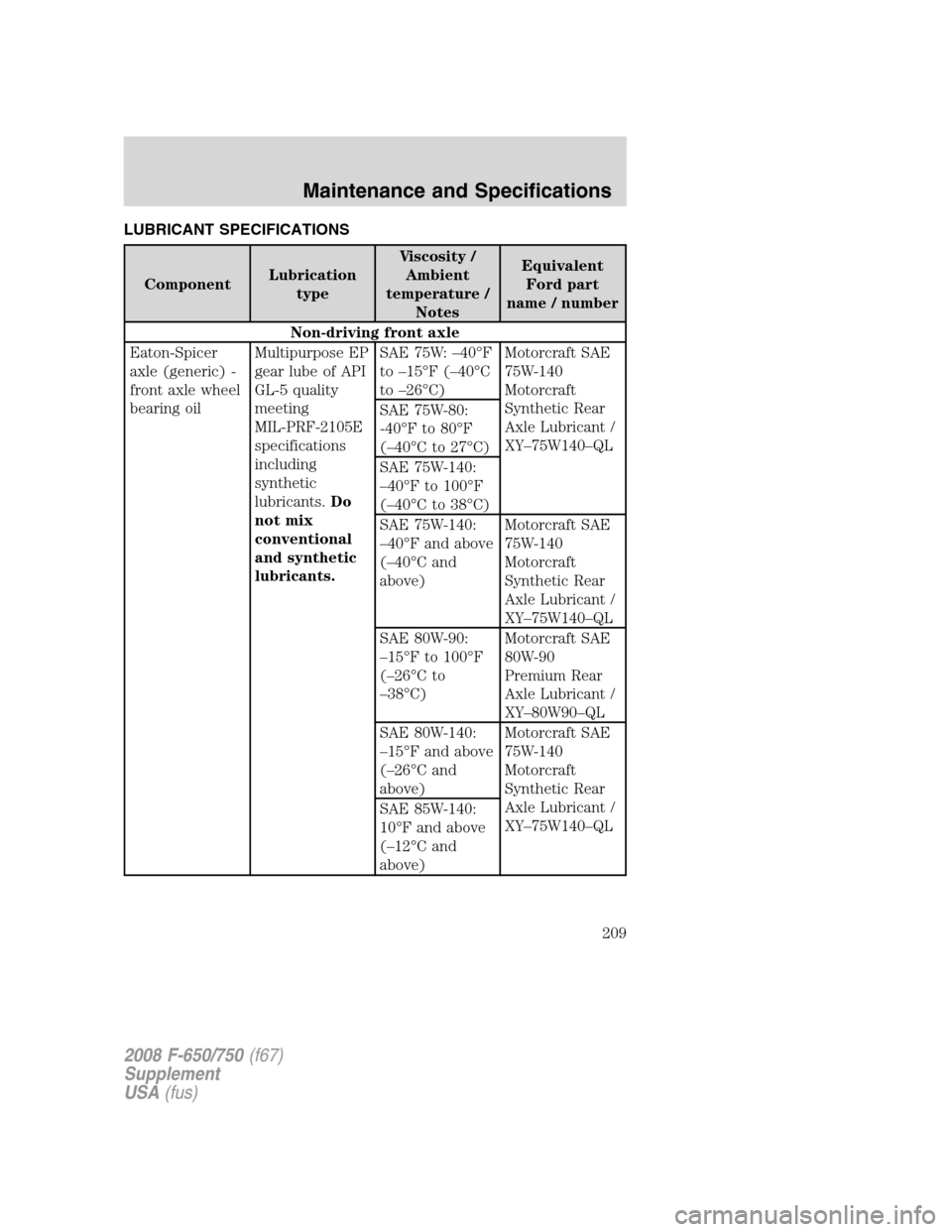
LUBRICANT SPECIFICATIONS
ComponentLubrication
typeViscosity /
Ambient
temperature /
NotesEquivalent
Ford part
name / number
Non-driving front axle
Eaton-Spicer
axle (generic) -
front axle wheel
bearing oilMultipurpose EP
gear lube of API
GL-5 quality
meeting
MIL-PRF-2105E
specifications
including
synthetic
lubricants.Do
not mix
conventional
and synthetic
lubricants.SAE 75W: –40°F
to –15°F (–40°C
to –26°C)Motorcraft SAE
75W-140
Motorcraft
Synthetic Rear
Axle Lubricant /
XY–75W140–QL SAE 75W-80:
-40°F to 80°F
(–40°C to 27°C)
SAE 75W-140:
–40°F to 100°F
(–40°C to 38°C)
SAE 75W-140:
–40°F and above
(–40°C and
above)Motorcraft SAE
75W-140
Motorcraft
Synthetic Rear
Axle Lubricant /
XY–75W140–QL
SAE 80W-90:
–15°F to 100°F
(–26°C to
–38°C)Motorcraft SAE
80W-90
Premium Rear
Axle Lubricant /
XY–80W90–QL
SAE 80W-140:
–15°F and above
(–26°C and
above)Motorcraft SAE
75W-140
Motorcraft
Synthetic Rear
Axle Lubricant /
XY–75W140–QL SAE 85W-140:
10°F and above
(–12°C and
above)
2008 F-650/750(f67)
Supplement
USA(fus)
Maintenance and Specifications
209